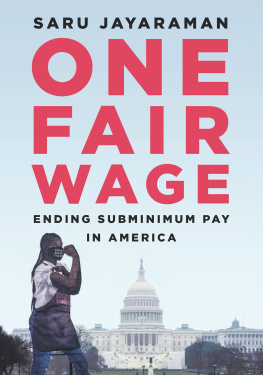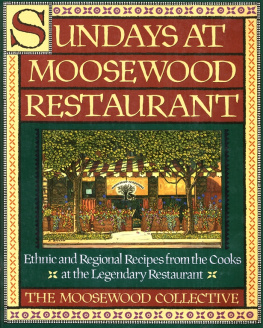B EHIND THE K ITCHEN D OOR
S ARU J AYARAMAN
W ITH A F OREWORD BY E RIC S CHLOSSER
ILR P RESS
AN IMPRINT OF
C ORNELL U NIVERSITY P RESS
I THACA AND L ONDON
To the more than 10 million restaurant workers nationwide, who struggle daily to feed us
C ONTENTS
F OREWORD
A powerful social movement has recently arisen in the United States, challenging industrial agriculture, questioning the American diet, and calling for fundamental changes in how we grow, process, and think about our food. Organic production has soared, and the need for sustainability has become so widely accepted that even companies like McDonalds and Coca-Cola now pay lip service to that worthy goal. The mistreatment of livestock at factory farms has gained enormous attention as consumers express revulsion at the cruelties routinely inflicted to obtain cheap meat. Free-range poultry, cage-free hens, grass-fed cattle, hogs allowed to wander outdoors and wallow in the mud, have all been championed as crucial elements of a healthier, more humane food system. But the food movement thus far has shown a much greater interest in assuring animal welfare than in protecting human rights. You would think that, at the very least, the people who feed us deserve as much attention and compassion as what were being fed.
The abuses endured by American farmworkers, meatpacking workers, and restaurant employees violate even the most watered-down, corporate-flavored definition of sustainability. Our food system now treats millions of workers like disposable commodities, paying them poverty wages, denying them medical benefits and sick pay, and tolerating racism and sexism on the job. The hardships of farmworkers and meatpacking workers have been well documented. This book eloquently reveals what is happening behind the kitchen door not only at chain restaurants, but at some of the most expensive restaurants in the United States.
Today its not uncommon for celebrity chefs to earn millions of dollars a year, while the dishwashers and bussers in their kitchens get a wage of $2.13 an hour, plus a meager share of the tips. The typical restaurant worker makes about $15,000 a year, roughly one-third the annual income of the average American worker. And for decades the restaurant industry has led the battle against increasing the federal minimum wage. Since the late 1960s, the value of the minimum wage, adjusted for inflation, has declined by about 20 percent. For the poorest workers in the United States, that has meant an hourly pay cut of about $1.50.
When people ask what are the most important changes that we could make to our food system right away, I reply: Enforce the nations labor laws and increase the minimum wage.
For more than a decade, Saru Jayaraman has been defending the rights of those who work hard but nevertheless find themselves at the bottom of the food chain. The organization that she helped found, Restaurant Opportunities Centers United, doesnt just represent workers. It seeks to empower them, gain them respect, and give them a voice in the workplace. Behind the Kitchen Door describes how Jayaraman got involved in this struggle, places it in a larger social context, and tells stories about individual workers that convey, more powerfully than any statistics, why we must not tolerate these injustices. Too many of our meals are now brought to the table by the misery of others. The problem can easily be solved, once people become aware of itand thats why this book needs to be read.
Eric Schlosser, June 2012
A CKNOWLEDGMENTS
There are so many people to thank.
First, of course, Id like to recognize all the staff, restaurant worker members, board members, allies in the food justice and other movements, and other supporters of the Restaurant Opportunities Centers United, who have coauthored this book through their hands, hearts, and minds. Without their hard work and contributions, the movement for change in the restaurant industry would never have come as far as it has. Many thanks especially to the members and staff profiled in this book and to ROC member, leader, and friend Sekou Luke for producing the extraordinary video trailer; ROCs research staff, Jonathan Hogstad and Teofilo Reyes, for data assistance; other national staff, including Meghana Reddy, Cathy Dang, Rekha Eanni, Juan Carlos Romero, and Christine Saunders, for support and promotion; executive team members Jose Oliva, Bonnie Kwon, Jennifer Dillon, and Sekou Siby for leadership; board members Rinku Sen and Abel Valenzuela for guidance; our film industry partner Joselyn Barnes for videography; our food justice partners at Slow Food; all of our funders, including Laine Romero-Alston and her colleagues at the Ford Foundation for supporting ROCs work and the books promotion, Swanee Hunt and the Prime Movers Fellowship for providing me with the time to write, and our friends at the Ms. Foundation for providing space to write; our dear friend and comrade Bruce Herman, who dedicated so much of his lifes energy to our movement; and my cofounder, codirector, and best friend, Fekkak Mamdouh. There are so many others unnamed but just as valuable to this movement to whom I am grateful.
Second, Id like to thank the book doctor, Esther Cohen, who spent countless hours helping me shape our data and stories into a book at the beginning, and my editor, Adrienne Davich, who spent an equal amount of time helping to finesse the book at the end. Thanks to Zachary Norris, Alex Kellogg, LaNysha Adams, my dad, and my sister Niru for taking the time to read the book and offer comments. Thanks also to Frances Benson and Cornell University Press for believing in us.
Finally, Id like to thank my family for their unconditional love and support: my partner, Zachary Norris; daughters, Akeela Lalitha and Lina Abiani Norris-Raman; and my parents and sisters.
T HE H ANDS ON Y OUR P LATE
When you work in restaurants you think the industry is everything. Its being outside, talking to people, serving people. You feel like youre part of something good. People mostly go to eat out for good stuffproposals, weddings, birthdaysnot to fight. Youre part of someones proposalyou bring the ring in an ice cream cake, you watch her reaction. You feel like youre part of their experience, their special moment, even if the people dont care who you areyoure just the server. Everywhere I go, I find restaurant workers are the same. They may move from restaurant to restaurantmaybe they dont earn enough money, or they dont like the way theyre being treated. But they always come back. They have a hospitality mentality in their DNA. All over the world, they have it in them. S ERVER , M AN , 17 Y EARS IN THE I NDUSTRY , N EW Y ORK C ITY
The events that forever changed me as a dinerand ultimately led to the writing of this bookhappened shortly after 9/11. I had never given much thought to the inner workings of restaurants or the lives of restaurant workers, but a few weeks after the Twin Towers fell I received a call from a union leader representing workers from Windows on the World, the luxurious multilevel restaurant that had been at the top of the World Trade Center. Windows on the World had earned acclaim for its international cuisine and for its staff from almost every nation in the world. The caller wanted me to help build an organization to support the displaced Windows workers and some 13,000 other restaurant workers in New York City who had lost their jobs after the 9/11 tragedy. She knew I had experience organizing immigrant workers, including restaurant workers, on Long Island and that Id helped start Women and Youth Supporting Each Other, a national organization serving young women of color. But I had never actually worked in a restaurant.
I was also young. Id always loved eating out, but I had no idea that, in accepting the union leaders offer and becoming at 27 the leader of a new restaurant workers organization, Id spend the next 11 years of my life meeting low-wage restaurant workersservers, bussers, runners, dishwashers, cooks, and otherswho are struggling to support themselves and their families under the shockingly exploitative conditions that exist behind most restaurant kitchen doors.
Next page








